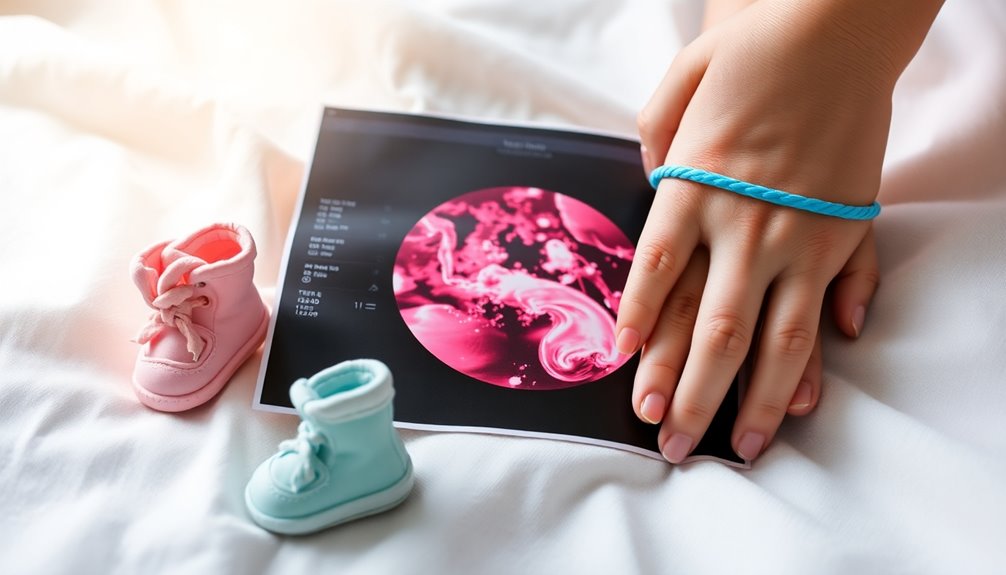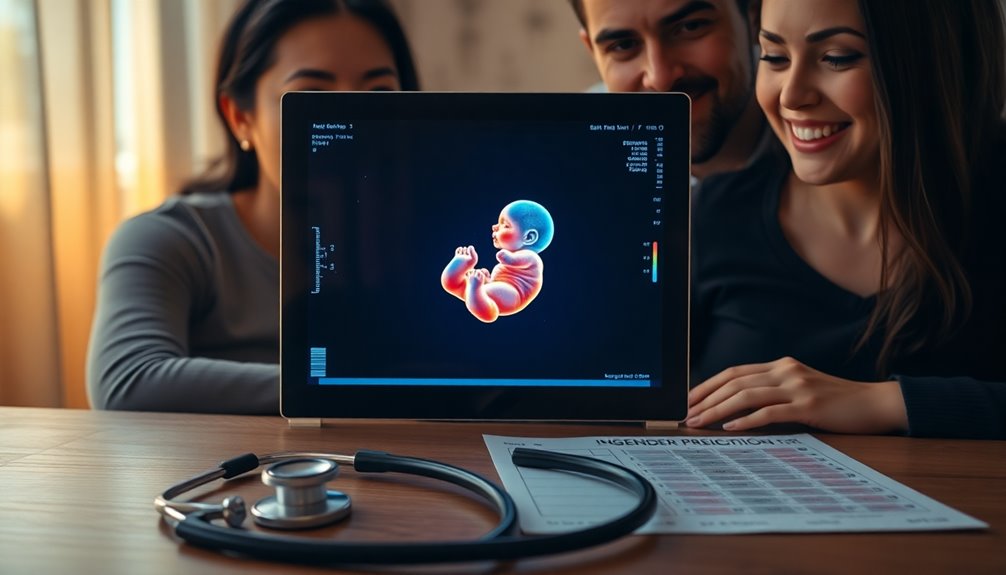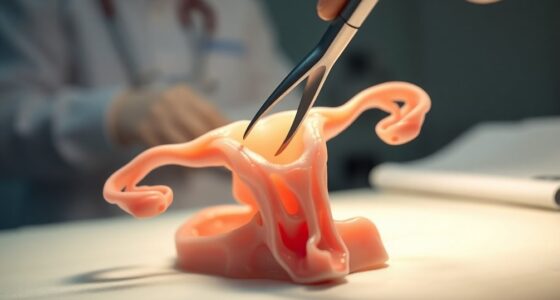A baby's gender is determined at conception when the sperm (X or Y) fertilizes the egg (X). If the sperm contributes an X, you'll have a girl (XX); if it contributes a Y, you'll have a boy (XY). This chromosomal combination sets the stage for gender development, which begins around the 7th to 8th week of pregnancy. Want to know more about how to predict gender or the methods used? Keep exploring!
Key Takeaways
- Baby's gender is determined at conception based on the combination of sex chromosomes from the egg and sperm (XX for female, XY for male).
- Differentiation of genital structures begins around 7 to 8 weeks of pregnancy, influenced by the presence of the Y chromosome.
- Noninvasive prenatal testing (NIPT) can accurately determine gender as early as 10 weeks through fetal DNA analysis from maternal blood.
- Ultrasound accuracy for gender determination improves significantly, reaching nearly 100% by 13 weeks into the pregnancy.
- Nub Theory allows for early gender prediction at 11 weeks by assessing the angle of the genital tubercle with up to 93% accuracy.
When Is a Baby's Gender Determined at Conception?

When a baby is conceived, their gender is already determined by the combination of sex chromosomes. The egg contributes an X chromosome, while the sperm can offer either an X or a Y chromosome.
If the sperm provides an X, the resulting XX combination leads to the development of female genital structures. Conversely, if the sperm contributes a Y chromosome, the XY combination results in male genital structures.
This differentiation begins around weeks 7 to 8 of pregnancy, following a period where both male and female embryos develop similarly. The presence of the Y chromosome initiates the formation of male characteristics, while its absence allows for female characteristics to emerge. Additionally, factors such as balanced diet during pregnancy can influence the overall health of the developing fetus.
Methods for Early Gender Prediction

Determining your baby's gender early in pregnancy can be an exciting prospect for expectant parents. Here are some methods you can consider for gender prediction:
Discovering your baby's gender early in pregnancy can be thrilling for parents-to-be, offering a glimpse into your future together.
- Noninvasive prenatal testing (NIPT) analyzes fetal DNA from your blood as early as 10 weeks.
- Ultrasound, typically accurate after 13 weeks, provides strong indications of the sex of your baby.
- The Nub Theory looks at the genital tubercle angle, offering up to 93% accuracy as early as 11 weeks.
- Chorionic villus sampling (CVS) can definitively determine sex between 10-13 weeks but involves risks.
- Amniotic fluid testing through amniocentesis is accurate from 15-20 weeks.
These methods can help you enthusiastically anticipate the arrival of your little one! Additionally, it's essential to discuss any concerns about prenatal testing with your healthcare provider, as they can provide insights into the importance of early detection of potential health issues.
The Role of Ultrasounds in Gender Determination

When you're looking to find out your baby's gender, timing is everything with ultrasounds.
You can get insights as early as the end of the first trimester, but accuracy skyrockets as you approach 13 weeks.
Understanding the Nub theory can also help you predict the gender based on the baby's developing anatomy during this vital period. Additionally, the importance of nutrition during pregnancy can significantly impact fetal development, including the growth of essential organs.
Ultrasound Timing and Accuracy
Ultrasounds play an essential role in gender determination, especially during key stages of pregnancy. You can start to determine your baby's gender as early as the end of the first trimester, but the accuracy improves considerably in the second trimester.
Here are some important points to take into account:
- At 11 weeks, accuracy is around 70.3%.
- By 12 weeks, accuracy jumps to 98.7%.
- Nearly 100% accuracy is reached by 13 weeks.
- Mid-pregnancy ultrasounds (18 to 22 weeks) are the most reliable for gender determination.
- The nub theory analyzes the genital tubercle angle but isn't guaranteed.
Additionally, it's important to remember that individual responses vary when it comes to reactions to pregnancy news, which can be influenced by factors such as personal circumstances and emotional support.
Nub Theory Explained
As you explore the various methods for gender determination, the Nub Theory stands out as a fascinating approach that relies on ultrasound imaging.
This theory suggests that the angle of the genital tubercle, or nub, can indicate the baby's gender when assessed between 11 to 13 weeks. An angle greater than 30 degrees usually suggests a male, while less than 10 degrees indicates a female.
A study found that this non-invasive method achieved 93% accuracy in gender prediction. While ultrasounds provide early gender insights, their primary focus remains on fetal development and health. Additionally, understanding newborn feeding options is crucial for ensuring proper nutrition during this early stage of development.
Understanding the Nub Theory

Understanding the Nub Theory can be fascinating for expectant parents enthusiastic to learn their baby's gender early on. This theory suggests that the angle of the genital tubercle, or "nub," can indicate the baby's gender as early as 11 to 13 weeks through an early ultrasound.
- Angles greater than 30 degrees suggest a male.
- Angles less than 10 degrees suggest a female.
- The genital tubercle starts differentiating around 7 to 8 weeks.
- It offers a non-invasive method for gender prediction.
- A study showed an accuracy rate of about 93%.
While the Nub Theory can provide insights, remember that ultrasound remains primarily a medical assessment tool and should be viewed as a supplementary method rather than a definitive answer. Additionally, this early gender prediction occurs during a critical period for skill acquisition and learning, emphasizing the importance of accurate assessments during pregnancy.
Accuracy of Gender Prediction Tests

Although various gender prediction tests are available, their accuracy can vary considerably depending on the method used and the timing of the test.
The NIPT blood test can detect your baby's sex as early as 10 weeks with high accuracy by analyzing male Y chromosomes in maternal blood.
Ultrasound examinations around 18-20 weeks can provide nearly 100% accuracy, though earlier scans may be less reliable.
The Peekaboo early gender test claims 99.5% accuracy by identifying the Y chromosome from a small blood sample taken as early as 7 weeks.
While studies show 90% accuracy at 12 weeks, factors like the baby's position and your body mass index can influence results.
Home kits offer a mere 50/50 chance and shouldn't replace medical testing. Additionally, many expectant parents are exploring plant-based diets to maintain health during pregnancy, which can be beneficial for overall well-being.
The Development of Baby's Genitalia

The development of your baby's genitalia begins soon after conception, influenced by the sex chromosomes inherited from both parents. At this stage, your baby's gender is determined, with XX for females and XY for males.
Initially, both male and female embryos share identical structures. Around weeks 7 to 8 of pregnancy, genital differentiation kicks in, and male sex organs develop due to the Y chromosome and testosterone.
By approximately 14 to 15 weeks, you can use an anatomy ultrasound to determine gender more accurately.
- Genital ridge formation
- Differentiation begins at 7-8 weeks
- Male genitalia development influenced by testosterone
- Gender determination possible by 14-15 weeks
- External genitalia changes continue until week 20
Additionally, understanding assisted living expenses can be important for those planning for the future as they prepare for family and financial needs related to parenthood.
Navigating the Excitement of Gender Reveal Parties

As you anticipate the arrival of your little one, planning a gender reveal party can add an extra layer of joy and excitement to your journey.
With about 69% of parents enthusiastic to know their baby's gender, these celebrations help you prepare your nursery and share the moment with family and friends.
The thrill often lies in the surprise element, whether you choose to cut a cake with colored filling, pop balloons filled with confetti, or use creative reveals like colored smoke bombs.
Engaging in social media challenges can also amplify the fun, as families share their unique moments online.
Ultimately, a gender reveal party fosters community, creating lasting memories while you predict your baby's gender. Additionally, these events can strengthen emotional connections and celebrate the importance of relationships in your growing family.
Frequently Asked Questions
How Early Can Baby Gender Be Detected?
You can detect your baby's gender as early as 10 weeks into your pregnancy through noninvasive prenatal testing (NIPT).
This method analyzes your blood for male sex chromosomes.
If you're looking for a visual confirmation, an ultrasound can often indicate the baby's sex starting at 13 weeks, with improved accuracy by 20 weeks.
For earlier, definitive results, procedures like chorionic villus sampling (CVS) can provide answers within just a few days.
When Did Finding Out the Gender of Your Baby Become a Thing?
Finding out your baby's gender became more mainstream in the 1950s with the introduction of ultrasound technology.
However, it wasn't until the early 2010s that noninvasive prenatal testing (NIPT) allowed you to discover the gender as early as 10 weeks into pregnancy.
Before that, cultural practices and old wives' tales were common, but modern methods have transformed how and when you can learn about your baby's gender.
In Which Week Is Baby Gender Confirmed?
You can typically confirm your baby's gender during a Level 2 anatomy ultrasound, which is best performed between 18 to 22 weeks of pregnancy.
By this point, the development of the genitalia is clear enough for accurate identification.
However, if you're keen to know earlier, noninvasive prenatal testing (NIPT) can reveal the gender as early as 10 weeks by analyzing your blood for male sex chromosomes.
At What Week Is Gender Identity Determined?
Think of a seed sprouting, where gender identity begins to take root at conception.
You'll find that actual differentiation starts around weeks 7 to 8, leading to clearer male or female genitalia by weeks 14 to 15.
While ultrasounds can hint at gender from about week 11, the most accurate determinations typically happen between weeks 18 to 22.
Conclusion
In the grand tapestry of life, knowing your baby's gender is like catching a glimpse of the colors yet to unfold. From conception to that thrilling ultrasound, each moment is a thread woven with excitement and anticipation. As you prepare for the joyous reveal, remember that the true essence of your journey lies not just in the colors you'll celebrate, but in the love and dreams you'll nurture as your little one grows. Embrace the mystery; every stitch is part of your unique story.









